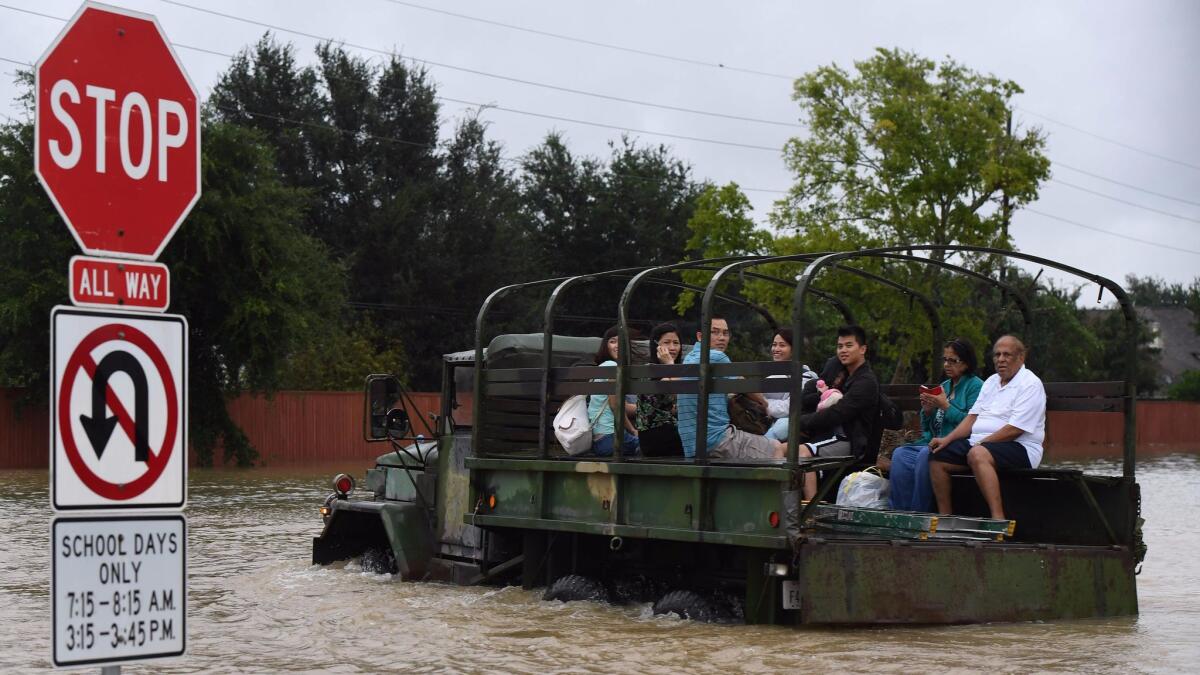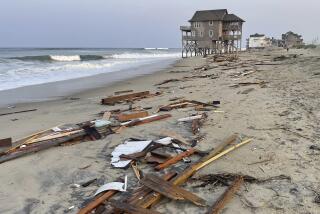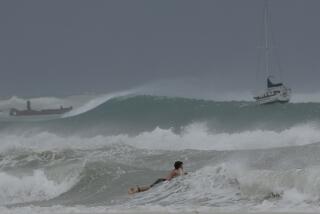Catastrophic storms, once rare, are almost routine. Is climate change to blame?

Climate change didn’t cause Tropical Storm Harvey, but it could explain recent catastrophic storms. (Aug. 31, 2017)
While climate change did not cause Hurricane Harvey, it could explain the intensity of this tropical cyclone as well as other catastrophic storms that have hit the United States in recent years, experts say.
Harvey is the latest in little over a decade of “500-year” and “100-year” floods that once were considered rare. The storm, a Category 4 hurricane when it initially made landfall last week, has dumped trillions of gallons of water onto southeastern Texas, submerged houses and freeways, driven Houston-area residents from their homes and resulted in more than 20 deaths.
Climate change won’t mean more storms overall — but it probably will mean that that biggest storms become even bigger, scientists say.
For example, rising ocean temperatures could be making storms like Harvey bigger than they would be otherwise, said Michael Mann, a climate scientist at Pennsylvania State University. That’s because as the ocean’s surface temperature rises, the atmosphere’s ability to hold moisture goes up.
According to the Clausius-Clapeyron Equation, every 0.5 degrees Celsius of warming means an extra 3% or so of moisture in the air. And Harvey grew over an ocean that was 1 to 1.5 degrees Celsius warmer than just a few decades ago, which means there’s around 5% more moisture in the atmosphere, Mann explained.
More moisture means a higher chance of heavier rainfall and bigger flooding — both of which, in Harvey’s case, have been wreaking major havoc in the greater Houston area.
“There is a good chance it would have happened anyway,” Mann wrote of Harvey in an email. However, he added, “the impacts were likely greatly amplified by climate change.”
In this altered environment, with heavier rains, storms behave differently, said Kevin Trenberth, a climate scientist with the National Center for Atmospheric Research.
“The storm itself grows a little bit more intense, it gets a little bit bigger and it helps it to last longer,” Trenberth said.
Hurricanes usually start to wane soon after they make landfall, because they’re cut off from the supply of moisture from the ocean. Not so with Harvey, whose size allowed it to stay plugged into its power source in the Gulf.
“That’s a big factor with Harvey … it’s big enough that it still had spiral arm bands that were reaching out into the Gulf and bringing a lot of moisture into the storm,” Trenberth said, which “enabled it to keep going where most storms would have petered out.”
Harvey flooded Houston partly because it stalled over southeastern Texas for days, rather than moving northward, scientists said. While there are some hypotheses that this slowing may be caused by climate change in the Arctic, Anand Gnanadesikan, a climate scientist at Johns Hopkins University, said the two were unlikely to be linked.
Examining the dynamics shaping Hurricane Harvey may help researchers get a better handle on climate change, scientists said.
“We’ll see a number of scientific studies analyzing this event,” said Noah Diffenbaugh, a climate scientist at Stanford University. “The rapid development of the tropical cyclone that occurred, the strength of the landfall, the stalling over the coast that produced the very high rainfall totals ... these are all going to be questions that we’re going to see scientists try to answer.”
Another idea that may require a revisit? Calculating the risk of such storms in the future.
Harvey already has been called a 500-year flood, and by the time the storm has dissipated, it may well reach 1,000-year status. But the last decade or two have brought a slew of these supposedly rare storms, including two 500-year floods in the Houston area in 2015 and 2016.
So what exactly does a 500-year storm mean?
“This concept actually comes from hydrology, and it relates a lot more to precipitation than it does to hurricanes or to the storms themselves,” Trenberth said. It’s a concept typically used in assessing risk for flood insurance.
It does not mean that a given storm can happen only once per century or twice per millennium, he added. It means that, for any given year, in stable climate conditions, a storm of this magnitude has a 1-in-100 (or 500, or 1,000) chance of taking place. So yes, you can, theoretically, have multiple 1-in-100-year hurricanes in a row — it’s just a very unlikely event.
“As long as the climate isn’t changing, you can define these things reasonably well,” Trenberth said. “With climate change … what used to be a 500-year event is becoming a 70-year event or a 50-year event. It doesn’t mean that they’re common, but they’re no longer anything like as rare.”

As human populations continue to grow in coastal areas, some cities may not be built to handle such extreme “500-year” events, which may happen more often in the future, experts say.
“That’s what the changing climate has done,” Trenberth added. “It means the extremes are greater — and if we don’t adapt to these, if we don’t take them into account, if we don’t build more resilience, we will suffer the consequences.”
Follow @aminawrite on Twitter for more science news and “like” Los Angeles Times Science & Health on Facebook.
MORE IN SCIENCE
What should you say to a climate change skeptic?
Nighttime forecast for Mars: Bursts of rapidly falling snow
Should NASA keep flying flagship missions? A new report weighs in







